Top News
August 19, 2011 Ryukyu Shimpo
United States military officials have reported to their Japanese counterparts that the number of deserters from U.S. military bases in Japan has increased to 47, thirteen of whom have still not yet been located since both countries agreed on May 2008 to arrest these people. Fifteen of the 47 deserters, about 30% of the total were from U.S. bases in Okinawa, with seven still at large. Eighteen soldiers have given themselves up, but none of those belong to bases on Okinawa.
Kantoku Teruya, a member of the House of Representatives, received an answer from the National Police Agency to his inquiry regarding deserters. Teruya said, “It is possible that U.S. military deserters will resort to crime in order to get money. There are risks involved with these people hiding among the local populace.”
Among the seven not yet taken into custody, a marine who deserted in Okinawa in January 2004, the longest period for someone to remain at large, may still be hiding in the prefecture.
Eight have been taken into custody, including six found by the U.S. military and two located by the Okinawa Prefectural Police.
Following a taxi driver murder-robbery committed by a U.S. soldier in Yokosuka, Kanagawa Prefecture in March 2008, the governments of Japan and the United States have agreed to notify each other regarding deserters from U.S. bases. If soldiers desert, U.S. military officials will immediately ask the Japanese police to assist in securing their arrest, and to report the situation to local governments through the Ministry of Foreign Affairs. Based on a special criminal law clause in the U.S.-Japan Status of Forces Agreement, Japanese authorities are required to hand over deserters to the United States if the Japanese investigative organizations apprehend the soldiers.
(English Translation by T&CT, Mark Ealey)
Go To Japanese

August 19, 2011 Ryota Shimabukuro of Ryukyu Shimpo
Japanese rock band HY, whose members are all from Okinawa, and RYUKYUKOKU MATSURI DAIKO (Ryukyu Kingdom Festival Drums), an international dance and drum performance troupe, will perform together at the 56th Okinawa Zento Eisa Festival in Okinawa City on August 21.
Both groups will perform HY’s Tokiwokoe (Beyond Time), a song written based on stories told by their grandparents who survived horrific experiences in the Battle of Okinawa and went on to boldly live their lives in Okinawa after the war.
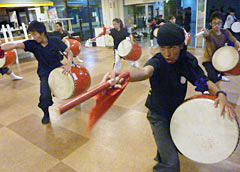
The members of RYUKYUKOKU MATSURI DAIKO practice Eisa at the Nakagusuku Mall in Nakagusuku Village on August 11
Four of the members of
RYUKYUKOKU MATSURI DAIKO are from its chapter in Miyagi Prefecture, which is among the earthquake-stricken areas.
HY’s vocalist Izumi Nakasone, who wrote and composed the song, said, “I hope that the live performance stimulates the audience not only to feel the preciousness of peace and life but also to look for a beacon of hope in their own lives.”
Two hundred and sixty members of the RYUKYUKOKU MATSURI DAIKO will participate in the festival and beat their drums to the tune of the song.
Takeo Medoruma, who directs the dance and drum performance, is excited about the festival, saying, “We will give our all to convey the message that even though people may lose everything, they must go on to overcome hardships and move forward.”
Head of the Miyagi chapter, 33 year-old Takayo Amatake said, “The great hardship that we endured because of the Great East Japan Earthquake has not dented our passion for the drums. We know that everyone is concerned about us – that’s why we need to practice really hard and prepare for the performance with exactly the same passion as before the disaster.”
Although HY and RYUKYUKOKU MATSURI DAIKO have collaborated before in music events such as the Peaceful Love Rock Festival and on HY’s national tour, it is the first time for them to perform together in an Okinawan music event involving a range of generations, from children to the elderly.
The members of HY are from Higashi Yakena, Uruma City, where Eisa is very popular.
HY’s drummer, Shun Naka said, “We are familiar with the sound of drums and sanshin in Eisa. I really think that the shouts and songs in Eisa resemble the pulse of the life.”
The band’s vocalist, Hideyuki Shinzato, said, “I am glad to participate in this traditional music event that has been going for such a long time in Okinawa. Traditional Eisa, creative Eisa and rock band music are mixed together in this festival. I would like the performers and the audience to be united in their feelings of peace and life and become a source of power to those people in the afflicted areas.”
(English Translation by T&CT, Mark Ealey)
Go To Japanese
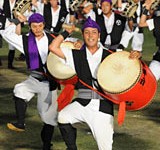
August 22, 2011 Ryukyu Shimpo
On August 21, 15 groups took part in the final day of the 56th Okinawa Zento Eisa Festival which was organized by the 56th Okinawa Zento Eisa Festival Executive Committee, comprising representatives from Okinawa City, the Ryukyu Shimpo, Okinawa Television Broadcasting, Okinawa City Tourism Association and Okinawa City Youth Group Commission.
The ceremonial and dynamic Eisa dance, in which regional traditions are still very much in evidence, and a glamorous variant – a women’s dance based on Ryukyu dance – were performed.
Koza Athletic Park, the venue for the festival, was packed with families and tourists enjoying the Eisa dance performance.
According to the event organizer, a new record of 330000 visitors enjoyed the festival over the three-day period, which included a michijune.
To bring the festival to a close, the members of the Yamazato Youth Group of Okinawa City performed a hearty Eisa dance that incorporated karate kata.
At the end of the festival the spectators participated in kachashi, a form of festive Ryukyuan folk dance, performed to the most popular of all kachashi dance songs: Toshin doi (A Chinese Ship Is Coming). An air of excitement prevailed throughout the event.
(English Translation by T&CT, Mark Ealey)
Go To Japanese
Slideshow of the 56th Okinawa Zento Eisa Festival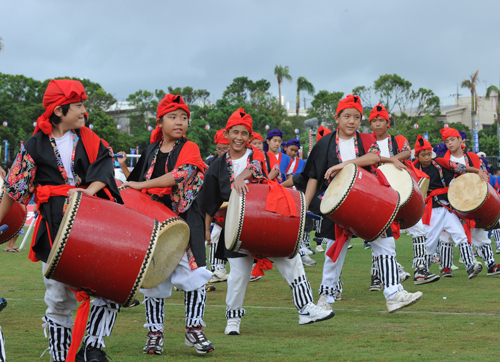

Go To Video
August 18, 2011 by Kenyu Uchima and Wakako Oshiro of Ryukyu Shimpo
Papers of the United States National Archives recently revealed that during the 1960s, the period of the Vietnam War, the U.S. military carried out training with small nuclear weapons at Camp Hague, located in what was then Okinawa City and Gushikawa City (now Uruma City). The document is contained in monthly reports for the period from the mid to late 1960s, which were released by the 3rd Marine Division of the United States Marine Corps stationed in Okinawa. It states that “Special Weapons Training” (which in U.S. military terminology means nuclear weapons) had been conducted.
Shoji Niihara, a researcher on the history of relations between Japan and the United States, located official documents published by the National Archives on the Internet. In addition to the training, the documents contain reference to a “Nuclear Weapons Refresher” (re-education program for the nuclear weapons). With regard to the venue for the training, it clearly states “Camp Hague” and “Okinawa.” It also noted details of the number of officers and NCOs who participated in the training.
“Nuclear Safety Officers” suggests that they carried out training for safe handling of nuclear weapons and to protect themselves in the event of coming under nuclear attack. According to some reports, a soldier transferred to Okinawa from Vietnam testified that he was exposed to radiation during the training.
The same documents state that the training was held on an irregular basis, and was often conducted between 1966 and 1968. Niihara speculated that, “U.S. Forces would have worked on the assumption that they would find themselves in the situation in which they would use nuclear weapons. The period in question overlapped with the Battle of Khe Sanh in which the fighting intensified in Vietnam, so the operational unit underwent training for nuclear weapons in preparation for their possible use.”
Camp Hague for the U.S. Marine Corps was located in Noborikawa, Okinawa City (formerly Misato Village), and was land taken over by U.S. forces in 1945. The land used by the Camp was returned to the local authorities in the period from 1964 to 1977.
(English Translation by T&CT, Mark Ealey)
Go To Japanese
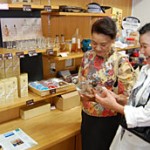
August 18, 2011 Yukihito Kinjo, correspondent of Ryukyu Shimpo
Sales of Ie-rum Santa Maria made from sugar cane grown on Iejima that started in July are going well.
Very little stock remains in the shop and the factory and for Internet orders.
Many shoppers who visited the Ie Bussan Center were interested in Ie-rum. According to a member of the staff, it is the most popular item at the Center.
There are two types of Ie-rum sold, one called “Gold” which is matured in oak barrels, and another called “Crystal” which is aged in stainless steel barrels. Both varieties are 37 degrees alcohol, and are priced at 2500 yen for a 720 ml bottle, 1400 yen for a 300 ml bottle, and 400 yen for a 50 ml bottle. The Center will produce 30000 bottles in fiscal 2011.
Tsuyoshi Matsumoto, managing director of the Center, “We are rather surprised by the response. Our focus is on creating a good product so we will not rush to make more to meet the immediate demand. We hope that you will be served an even better product with the next batch.”
The next shipment is due for the end of September and there are already some advance orders.
Please direct advance orders for Ie-rum to the Iejima Bussan Center. Telephone: 0980 (49) 5555 or Ie-mono Honpo for Internet orders in limited quantities
(http://www.ie-mono.com/SHOP/819077/list.html).
(English Translation by T&CT, Mark Ealey)
Go To Japanese
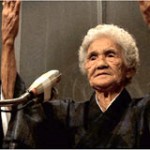
August 17, 2011 Ryukyu Shimpo
Sketches of Myahk (directed by Koichi Onishi), a documentary movie focusing on the spiritual songs passed on through the ages in the Miyako Islands was awarded Special Mention of the Critics Week Jury 2011, a second Grand Prize in the category of Critics’ Week in 64th Locarno International Film Festival held in Switzerland from August 3 to 13.
Onishi said, “The movie succeeded in introducing to the world the songs and culture of the Miyako Islands, Okinawa and Japan.”
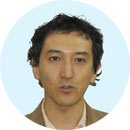
Koichi Onishi
Seven movies were screened in the category of Critics’ Week, which features documentary movies from all over the world.
Sketches of Myahk was screened on August 7 and 8. Onishi and Makoto Kubota, the musician who proposed the story and supervised the film, attended the screening. A Swiss filmmaker won the Grand Prize in the competition.
With regard to the screening of his film, Onishi said, “The audience seemed to react far better to my film than to those of other competitors. The applause just seemed to go on and on.” Onishi continued, “Organizers of other film festivals want to screen my film, so I think that the timing is good to pass on information about the Miyako Islands, Okinawa and Japan to the world.”
The film focuses on the culture and religion of the Miyako Islands by telling stories about elderly people who have inherited spiritual songs and folk songs that have been passed down in various regions of the Miyako Islands, and of women engaged in religious work.
The film will be screened in Okinawa from this November.
(English Translation by T&CT, Mark Ealey)
Go To Japanese
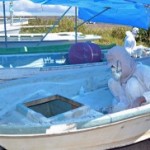
August 16, 2011 Ryukyu Shimpo
Miyako City of Iwate Prefecture suffered extensive damage in the Great East Japan Earthquake. Many fishing vessels were swept away or hurled up onto land by the tsunami.
Fishermen of the Katsuren Fishermen’s Cooperative who harvest mozuku, a type of edible seaweed found around Okinawa (biological name: Cladosiphon okamuranus), decided to collect eight small fishing vessels of about 10 meters in length that have not been used for several years, and repair them. One of the fishermen said, “The fishermen up there can make their living only by fishing. As people who are also engaged in fishing, we would like to do our best to help those in the tsunami stricken areas.”
The Fishermen’s Cooperative contacted the Marine Products Division of the Industrial Promotion Department of Miyako City and established that they need small fishing vessels to catch sea urchins and abalones. The Fishermen’s Cooperative will repair the damaged vessels and paint them as needed.
They are scheduled to hold a sending-off ceremony on August 22 and ferry the repaired vessels to Tokyo, before trucking them on to Miyako City.
Masaru Uehara, executive managing director of the Umiya Marine Products Company, said, “In cooperation with many people, we have been engaged in this project from the stage of repair work through to transportation. I hope that we can continue our support for the people in the tsunami stricken areas.”
The company is calling for donations of used fishing vessels and used fishing equipment.
For further details, call Umiya Marine Products Co. at 098 (878) 0503.
(English Translation by T&CT, Mark Ealey)
Go To Japanese
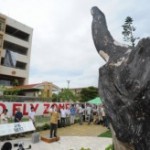
August 13, 2011 compiled from reports of Ryukyu Shimpo
A rally seeking to stop all aircraft from taking off from the United States Marine Corps Air Station Futenma was held at Okinawa International University in Ginowan City on August 13, exactly seven years since a U.S. helicopter crashed onto its campus. Many people including university officials and local residents participated in the rally held in front of the monument where the helicopter crashed.
Moritake Tomikawa, President of the University, voiced his dissatisfaction with the current situation in which the risk of such accidents has not been resolved despite seven years having passed. In addition, MV-22 Osprey vertical takeoff and landing transport aircraft will be deployed next year. Tomikawa also said, “We will seek to immediately stop all flights from taking off from the Futenma Air Station, so we can live safely, peacefully, and without worry.”
Go To Japanese

Go To Video
Ginowan City Officials seeking early closure of Futenma Air Station
August 12, 2011 compiled from reports of Ryukyu Shimpo
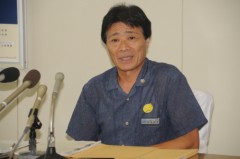
On the morning of August 12, at the Ginowan Municipal Office, Deputy Mayor of Ginowan City Seiei Komesu seeks closure and return of USMCAS Futenma.
Seiei Komesu, the Deputy Mayor of Ginowan City, held a press conference at municipal offices, on August 12, a day before the seventh anniversary of the helicopter crash. Acting for the Mayor who was on sick leave, he released a statement seeking the early closure and return of the Futenma Air Station, and the elimination of risk to local residents.
The deputy mayor pointed out the responsibilities of the governments of Japan and the United States, saying, “No real measures have been taken to eliminate problems such as noise pollution and other negative impact on the residents in the 15 years since the SACO agreement was signed.” He said also, “The helicopter crash is clear evidence of how dangerous this base is. The accident was the final warning for us of what can happen.”
With regard to the deployment of MV-22 Osprey aircraft to the Futenma Air Station next year, he indicated his firm opposition, saying, “The deployment will increase the risk to the local residents.” Regarding the relocation of Futenma Air Station, he said, “The functions of, and Marine Corps at, Futenma Air Station should be moved to U.S. territory such as its mainland, or to Hawaii or Guam.”
Go To Japanese
“Funny tales about military bases in Okinawa” performance reflects reality through biting satire
August 14, 2011 compiled from reports of Ryukyu Shimpo
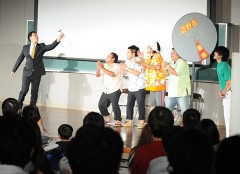
"Funny tales about military bases in Okinawa" by Performance Corps FEC at Okinawa International University, on August 13.
Performance Corps FEC held its first special version of “Funny tales about military bases in Okinawa” at Okinawa International University, on August 13, seven years since the helicopter crash. A large audience enjoyed short comedy skits with sharp satirical themes containing topical phrases such as “Futenma relocation outside the prefecture,” “Osprey,” and “Mr. Maher’s remarks.” The hall was packed with visitors and students from both within and outside the prefecture; so many that some people even had to stand.
In a parody of the popular TV show “Tokyo-based Friend” Prime Minister Naoto Kan played darts to choose where to relocate the U.S. Marine Corps Futenma Air Station. When he threw the dart it hit “Henoko” and then said, “It’s difficult to move Futenma ‘outside of the prefecture’ after all.” The audience responded with gales of laughter because most of the dart-board was occupied by “Henoko,” and there was only a very small space remaining for “outside the prefecture.”
Another skit had the former U.S. Consul General in Okinawa come to get a job in a lunch box stall saying repeatedly “Okinawan people cannot make even goya. Please do not put me with them,” and another was a funny tale that has a wedding speech by the bride being given in the midst of deafening noise from U.S. military aircraft. A total of 11 short comedies were performed.
Go To Japanese
(English Translation by T&CT, Mark Ealey)
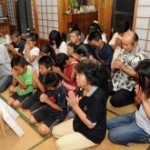
August 13, Ryukyu Shimpo
On August 12, the first day of Okinawa’s Obon called Unke, families who have family altars celebrated the return of their ancestral spirits with offerings of bananas and pineapples.
At the house of 74-year-old Kazuko Tokumoto, who resides in Komesu, Itoman City, 28 people from four households gathered at the family altar, pressed their hands together in prayer for their ancestors.
Dragon fruit cultivated by Koichi Tokumoto, Kazuko Tokumoto’s late husband who passed away three years ago, grew again this year so some were placed in the family altar.
The eldest son of Kazuko Tokumoto, 49 year-old Hiroshi Tokumoto, who resides in Goya, Okinawa City, pressed his hands together in prayer in front of a totome, or spirit tablet, saying, “Please look at my children. They’ve grown up.”
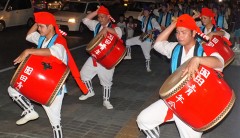
Boldly striking their drums, groups of Eisa dancers from the Sonda Youth Group moved through the streets near the Goya Crossroads in Okinawa City on the evening of August 12.
Throughout the prefecture troupes of Eisa dancers from Youth Groups moved through the streets and alleys of each community in what is called a
michijune. People attracted by the
michijune gathered along the roadside as the performers beat their drums boldly to the accompaniment of finger-flutes.
In most parts of the prefecture,
michijune continues until
Ukui, the final day of Obon on August 14.
The people of Okinawa City, which proclaims itself to be the “The City of Eisa,” look forward to the Okinawa Zento Eisa Festival scheduled to be held from August 19 to 21.
The members of the Sonda Youth Group performed a spectacular Eisa dance on National Route 330 and other areas, receiving cheers and applause from the people watching on the side of the road.
(English Translation by T&CT, Mark Ealey)
Go To Japanese

Go To Video

August 14, 2011 Ryukyu Shimpo
A former member of the U.S. military, a 61 year-old veteran who was stationed on Okinawa and now lives in United States, has said that in 1969 the U.S. military buried several dozen 55-gallon (208-liter) drums containing dioxin defoliant along the sea of Chatan Town on land since returned by the military. With regard to defoliant on U.S. bases in Okinawa, more than 100 veterans have submitted claims to the Department of Veterans Affairs for damage to their health due to exposure to the defoliant, which was sprayed, storage and transported in many facilities in the prefecture in the 1960s and 1970s, but this is the first such statement about the disposal of defoliant waste in the prefecture.
On August 13, the Japan Times reported that a former member of the military involved in transport operations for the U.S. Army supply depot from 1968 to 1970 has stated that Agent Orange was buried in Chatan Town. He explained this to Air Force veteran Joe Sipala, drawing a map of the location in Okinawa then known as Camp Hamby where he alleged in July that the defoliant was buried. Sipala, a 61-year-old resident of North Carolina, has claimed that his health problems are due to being exposed to the defoliant during his service at the Awase Communication Site in 1970. Sipala has been gathering information about Agent Orange in Okinawa.
According to the statement to Sipala by the former U.S. soldier, the man was involved in unloading cargo, including the defoliant, from a freighter that become stranded on rocks in 1969 when it was carrying supplies to U.S. forces. At that time, he also handled drums with orange stripes containing Agent Orange, and he was exposed to the defoliant as it leaked from cracks. He saw an operation in which they dug a large hole about 46 meters in length in Chatan Town and used a crane to put in several dozen drums containing Agent Orange, with the hole then being covered with soil.
A senior official of Chatan Town said that they have found nothing resembling drums during the land redevelopment project since the handover by U.S. military of Camp Hamby to the town in 1981. However, in 2002, a large number of drums containing an oily substance were discovered in the Mihama area, land returned by the U.S. military near what was Camp Hamby.
(English Translation by T&CT, Mark Ealey)
Go To Japanese
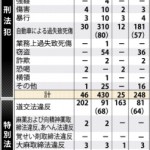
August 13, 2011 Ryukyu Shimpo
An investigation conducted by the Japan Peace Committee has revealed that the indictment rate for crimes (excluding vehicular manslaughter) committed by U.S. military personnel, including their family members and civilian personnel, in Okinawa was 16.2% in 2010.
The indictment rate for crimes (excluding vehicular manslaughter) committed by U.S. military personnel in all of Japan was 11.7%, considerably lower than the rate for Japanese which sat at 42.2%.
The statistics clearly indicate that both the U.S. and Japanese governments still accord special treatment to U.S. military personnel who have committed crimes.
The Japan Peace Committee submitted a request to the Justice Ministry for a data file of indicted and dropped cases of crimes and other incidents involving U.S. military personnel. The Ministry complied with the request, releasing the data file, which the Committee then used for its investigation.
The member of the Committee said, “The statistics reveal that the prosecutor’s office consistently adheres to a secret accord between Japan and the United States in which, except for major crimes, Japan waives its primary jurisdiction over crimes committed by the U.S. military personnel.”
The Committee’s investigation shows that the Naha District Public Prosecutors Office has accepted 300 (56.3%) of the 533 criminal cases involving the U.S. military personnel for the past ten years.
The Office has accepted 722 (67.7%) of all the crimes committed by the U.S. military personnel (1067) involving violations of special laws such as the Cannabis Control Act.
In the breakdown of cases involving U.S. military personnel that were either indicted and dropped, the number of traffic law violations and vehicular manslaughters were overwhelmingly high.
In the prefecture, 57 U.S. military personnel were exempted from prosecution for vehicular manslaughter and 64 exempted from prosecution for traffic law violations because these incidents were judged to have occurred while they were “on duty.”
(English Translation by T&CT, Mark Ealey)
Go To Japanese


















 Webcam(Kokusai Street)
Webcam(Kokusai Street)


